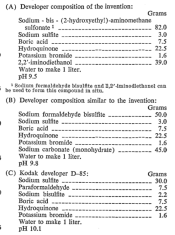Ron789
Subscriber
Doing some lith printing today.....
Choosing the best moment to "snatch" the print from the developer has always been a bit of a gamble for me, especially with paper that needs red safelights.
While making a test strip today I saw the image appearing and since it was only a test strip I decided to turn on the (plain, strong) white light to see what would happen, expecting that the print would darken very quickly. But it didn't. For minutes I watched the print developing and the image getting stronger and more contrasty.
Then I put the print in the stop bath, fix, selenium toner and water, all while the white light was on, and the result was just fine.
Thinking this thing through it started making perfect sense: in a lith print it takes several minutes (in my case, minimal 4 minutes) of development before the latent image becomes visible in the print. Turning on the plain white light during the last one or two minutes of the print development will create a new latent image all over the print but this will not be developed enough to become visible, since that would take another 4 minutes at least. By then, the print has gone through the stop bath and is in the fix.
So, it seems fine to watch the final phase of a lith print development in plain white light, making it much easier to snatch the print from the developer at the best moment!
Does anyone have any experience with this? Am I taking any (long term) risk doing this?
Choosing the best moment to "snatch" the print from the developer has always been a bit of a gamble for me, especially with paper that needs red safelights.
While making a test strip today I saw the image appearing and since it was only a test strip I decided to turn on the (plain, strong) white light to see what would happen, expecting that the print would darken very quickly. But it didn't. For minutes I watched the print developing and the image getting stronger and more contrasty.
Then I put the print in the stop bath, fix, selenium toner and water, all while the white light was on, and the result was just fine.
Thinking this thing through it started making perfect sense: in a lith print it takes several minutes (in my case, minimal 4 minutes) of development before the latent image becomes visible in the print. Turning on the plain white light during the last one or two minutes of the print development will create a new latent image all over the print but this will not be developed enough to become visible, since that would take another 4 minutes at least. By then, the print has gone through the stop bath and is in the fix.
So, it seems fine to watch the final phase of a lith print development in plain white light, making it much easier to snatch the print from the developer at the best moment!
Does anyone have any experience with this? Am I taking any (long term) risk doing this?




